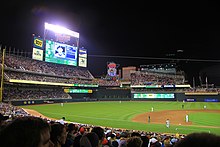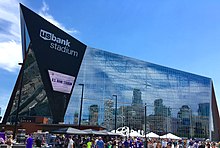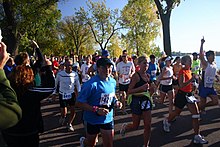Sports
Main articles: Sports in Minneapolis–Saint Paul and Sports in Minnesota
| Club | Sport | League | Since | Venue (capacity) | Championships |
|---|---|---|---|---|---|
| Minnesota Lynx | Basketball | WNBA | 1999 | Target Center (19,400) | 2011, 2013, and 2015 |
| Minnesota Timberwolves | Basketball | NBA | 1989 | Target Center (19,400) | |
| Minnesota Twins | Baseball | MLB | 1961 | Target Field (39,500) | 1987 and 1991 |
| Minnesota United FC | Soccer | MLS | 2015 | TCF Bank Stadium (50,805) | |
| Minnesota Vikings | American football | NFL | 1961 | U.S. Bank Stadium (65,400) | 1969 |
The Minneapolis Millers (pictured earlier, in 1905) included Ted Williams, Willie Mays and Carl Yastrzemski, all members of the Baseball Hall of Fame.[171]
The Minnesota Vikings and the Minnesota Twins have played in the state since 1961. The Vikings were an NFL expansion team, and the Twins were formed when the Washington Senators relocated to Minnesota. The Twins have won 10 division titles (1969, 1970, 1987, 1991, 2002–04, 2006, 2009, and 2010), 3 American League Pennants (1965, 1987 and 1991) and the World Series in 1987 and 1991. The Twins have played at Target Field since 2010. The Vikings have played in the Super Bowl following the 1969, 1973, 1974, and 1976 seasons (Super Bowl IV, Super Bowl VIII, Super Bowl IX, and Super Bowl XI, respectively), losing all four games.
The Minnesota Wild of the NHL play in St. Paul at the Xcel Energy Center.[177] The professional soccer team Minnesota United FC of the NASL played in suburban Blaine at the National Sports Center through 2016.[178] In 2017, the team joined the MLS and play the 2017 season in the University of Minnesota's TCF Bank Stadium, and then will relocate to St. Paul the following year when their new stadium has been built there.[179]
Other professional teams have played in Minneapolis in the past. First playing in 1884, the Minneapolis Millers baseball team produced the best won-lost record in their league at the time and contributed fifteen players to the Baseball Hall of Fame. During the 1920s, Minneapolis was home to the NFL team the Minneapolis Marines, later known as the Minneapolis Red Jackets.[180] During the 1940s and 1950s the Minneapolis Lakers basketball team, the city's first in the major leagues in any sport, won six basketball championships in three leagues to become the NBA's first dynasty before moving to Los Angeles.[181] The American Wrestling Association, formerly the NWA Minneapolis Boxing & Wrestling Club, operated in Minneapolis from 1960 until the 1990s.[182]
The 1,750,000-square-foot (163,000 m2) U.S. Bank Stadium was built for the Vikings for about $1.122 billion, over half financed by Vikings owner Zygi Wilf and private investment. Called "Minnesota's biggest-ever public works project," the stadium opened in 2016 with 66,000 seats, expandable to 70,000 for the 2018 Super Bowl.[183] Two thousand high-definition televisions are dominated by two scoreboards, the league's 10th largest, that together measure 12,560 square feet (1,167 m2) and are each larger than a city house lot.[183] Thanks to a state of the art Wi-Fi network, fans can order food and drink and have them delivered to their seats or ready for pickup.[184] A Vikings' vice president thought that the Vikings' Longhouse bar and concessions area and The Commons park could be attractions to those without football tickets.[185] Season tickets sold out before the football season began.[186] U.S. Bank Stadium will also feature rollerblading nights and will host concerts and events.[183]
The downtown Hubert H. Humphrey Metrodome, demolished beginning in January 2014, was the largest sports stadium in Minnesota from 1982 to 2013.[187] Major sporting events hosted by the city include the 1985 and 2014 Major League Baseball All-Star Games, the 1987 and 1991 World Series, Super Bowl XXVI in 1992, the 1992 NCAA Men's Division I Final Four, the 2001 NCAA Men's Division 1 Final Four and the 1998 World Figure Skating Championships.[188][189][190] Minneapolis has made it to the international round finals to host the Summer Olympic Games three times, being beaten by London in 1948, Helsinki in 1952 (when the city finished in second place), and Melbourne in 1956. In May 2014, the NFL announced that Minneapolis will host Super Bowl LII in 2018.[191]
Since the 1930s, the Golden Gophers have won national championships in baseball, boxing, football, golf, gymnastics, ice hockey, indoor and outdoor track, swimming, and wrestling.[192] The Gophers women's ice hockey team is a six-time NCAA champion and seven-time national champion.[193][194]
| Minneapolis stadiums at the University of Minnesota[195] | ||||||||||||||||||||
|---|---|---|---|---|---|---|---|---|---|---|---|---|---|---|---|---|---|---|---|---|
|
Parks and recreation
Minnehaha Falls is part of a 193-acre (78 ha) city park rather than an urban area, because its waterpower was overshadowed by that of St. Anthony Falls a few miles farther north.[196][197]
Theodore Wirth is credited with the development of the parks system.[201] Today, 16.6% of the city is parks and there are 770 square feet (72 m2) of parkland for each resident, ranked in 2008 as the most parkland per resident within cities of similar population densities.[202][203] In its 2013 ParkScore ranking, The Trust for Public Land reported that Minneapolis had the best park system among the 50 most populous U.S. cities.[204][205]
The 2006 Medtronic Twin Cities Marathon
Runner's World ranks the Twin Cities as America's sixth best city for runners.[208] Team Ortho sponsors the Minneapolis Marathon, Half Marathon and 5K which began in 2009 with more than 1,500 starters.[209][210] The Twin Cities Marathon run in Minneapolis and Saint Paul every October draws 250,000 spectators. The 26.2-mile (42.2 km) race is a Boston and USA Olympic Trials qualifier. The organizers sponsor three more races: a Kids Marathon, a 1-mile (1.6 km), and a 10-mile (16 km).[211]
The American College of Sports Medicine ranked Minneapolis and its metropolitan area the nation's first, second, or third "fittest city" every year from 2008 to 2016, ranking it first from 2011 to 2013.[212] In other sports, five golf courses are located within the city, with the nationally ranked Hazeltine National Golf Club and Interlachen Country Club in nearby suburbs.[213] Minneapolis is home to more golfers per capita than any other major U.S. city.[214] The state of Minnesota has the nation's highest number of bicyclists, sport fishermen, and snow skiers per capita. Hennepin County has the second-highest number of horses per capita in the U.S.[117] While living in Minneapolis, Scott and Brennan Olson founded (and later sold) Rollerblade, the company that popularized the sport of inline skating.[215]







No comments:
Post a Comment